Are you trying to keep up with the rapid changes in tech hiring?
You are not alone, as 67% of talent acquisition professionals see increased AI usage as a top trend shaping 2025 hiring strategies.
What worked in the past may no longer be enough, especially with AI, remote work, and skills-based hiring reshaping the recruitment landscape.
In this guide, we will break down the top 15 tech recruitment trends that will shape hiring success in 2025 and beyond.
Let’s dive in!
“The competition for tech talent is intensifying… The focal point for 2025? Enhancing hiring technology and adopting a skills‑centric recruitment approach.” Kristina Gekova – Strategic Executive
1. AI in recruitment is driving end-to-end automation
AI is at the center of talent acquisition trends for 2025, transforming the recruitment process from end to end.
Companies are now using automation to handle everything from writing job ads to scheduling interviews and other tasks that consume a significant amount of recruiters’ time.
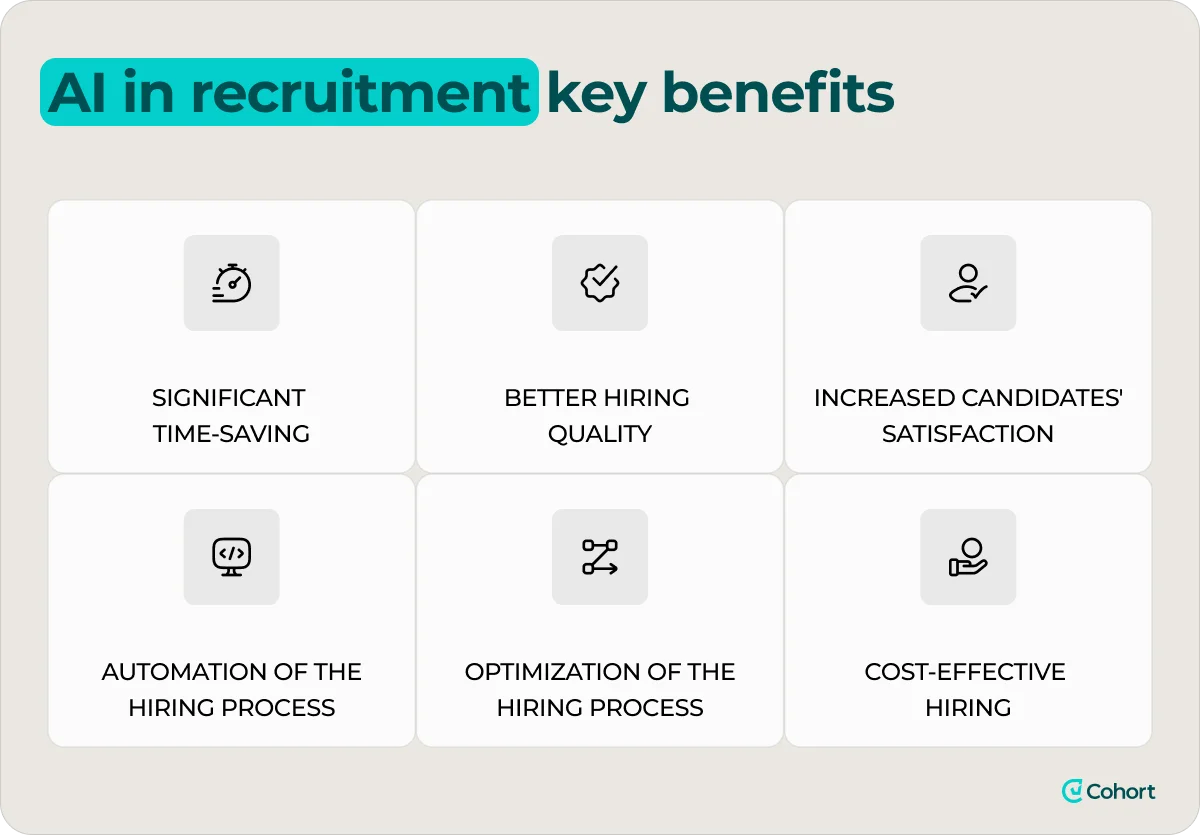
🧠 Why is it important?
92% of companies using AI in recruitment are already seeing benefits.
According to BCG’s research, 70% of HR teams that automated tasks saw noticeable time savings.
Some early adopters reported productivity gains of over 30%.
✅ Key impact on recruiter efficiency and time-to-hire:
Recruiters spend less time on admin and more time on human interactions, which leads to faster hiring and stronger candidate relationships.
🔧 How to act on it:
- Utilize AI platforms that quickly surface top candidates and keep them engaged in real-time.
- Automate repetitive tasks, such as screening, scheduling, and sending feedback emails.
- Start with AI tools that plug into your ATS or CRM.
2. Skills-based hiring trends are gaining momentum in tech
Skills-based hiring trends are gaining significant momentum, particularly in the tech sector.
Employers are realizing that formal degrees don’t always predict job performance, as real-world skills and hands-on experience often matter more.
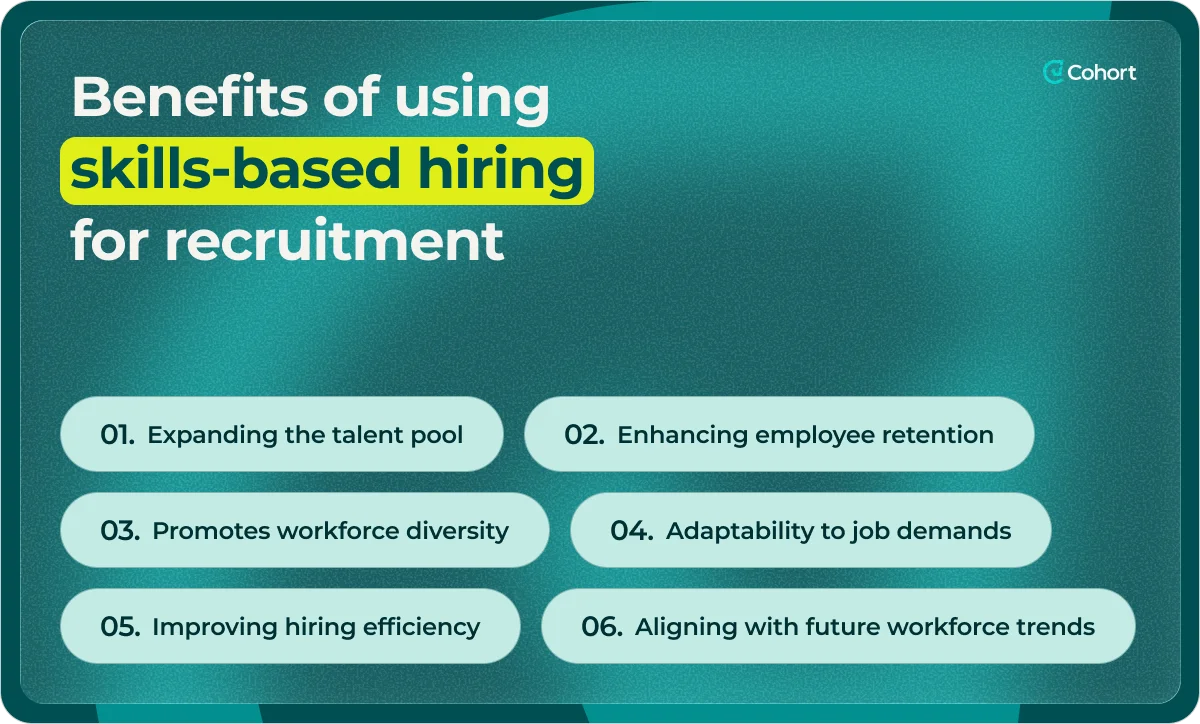
🧠 Why is it important?
70% of hiring managers already value skills over degrees, and 25% of US employers plan to eliminate degree requirements by 2025.
Removing degree requirements has been shown to boost diversity, increase applications, and maintain hiring quality.
✅ Key impact on diversity and talent pool expansion:
Skills-based hiring expands the talent pool, enhances equity, and enables companies to fill roles more quickly without compromising on quality.
🔧 How to act on it:
- Rewrite job descriptions to emphasize skills rather than credentials.
- Introduce practical assessments or projects during the screening process to evaluate candidates' skills and abilities.
- Train recruiters to evaluate portfolios and experience over education.
3. Remote and hybrid roles shaping the future of tech hiring
Remote and hybrid roles are now central to hiring trends in technology.
Candidates now expect flexibility as a baseline, and they’re choosing employers who offer it.
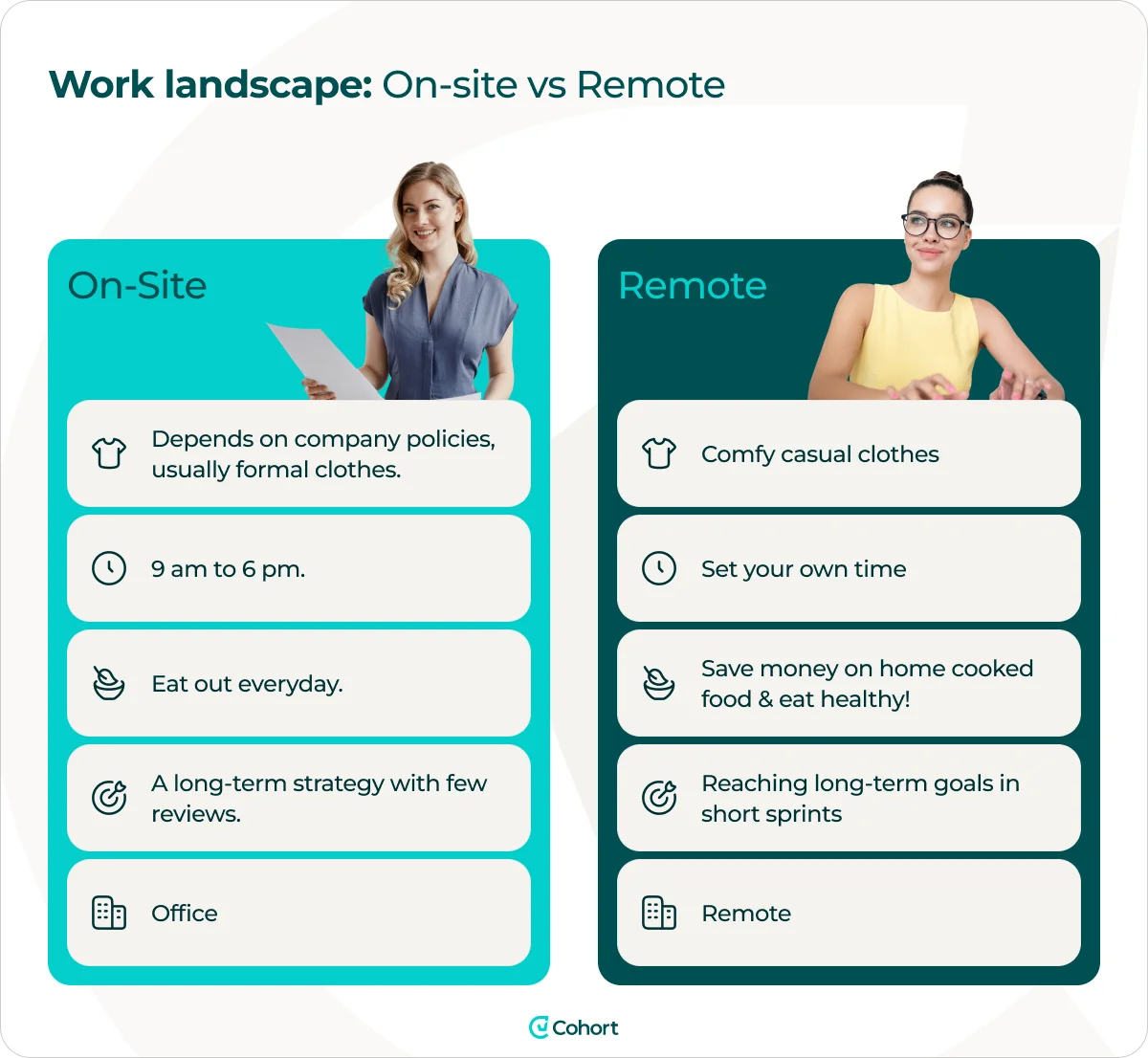
🧠 Why is it important?
About 40% of tech job postings in early 2025 offer remote options.
Research for Robert Half also found that nearly half (48%) of job seekers want a hybrid role, while over a quarter (26%) prefer to work fully remotely.
✅ Key impact on candidate reach and job attractiveness
Offering flexible roles helps recruiters access a broader talent pool and attract candidates who would otherwise be out of reach.
🔧 How to act on it
- Use job boards and sourcing tools that support remote job filters.
- Include remote/hybrid details in job ads.
- Prepare hiring managers to conduct fully remote interviews and onboard new employees.
4. Embedding DEI in talent acquisition strategies
Tech companies are under pressure to close representation gaps and build more inclusive workplaces.
That is why many companies now view DEI as a core part of their hiring and talent retention strategies, rather than as a separate project.

🧠 Why is it important?
Companies with more gender diversity are 25% more likely to outperform their peers financially.
Diverse teams bring a wider range of ideas, make better decisions, and contribute to stronger innovation and business growth.
✅ Key impact on inclusive hiring and team performance:
Inclusive hiring practices lead to more diverse pipelines, stronger teams, and a more innovative culture.
🔧 How to act on it:
- Use blind screening to reduce bias in resume evaluations.
- Structure interviews with consistent questions and a scoring system.
- Track DEI metrics from sourcing through final hire.
5. Data-driven talent acquisition for smarter hiring decisions
Hiring is becoming more scientific, and talent teams are tracking what works, so decisions aren’t based on gut feel but on evidence that leads to better hires.
🧠 Why is it important?
A single bad hire can cost between $25,000 and $50,000.
On the other hand, companies that utilize data-driven strategies are already seeing results, as some report 35% higher profitability compared to their competitors during the early stages of generative AI adoption.
✅ Key impact on hiring quality and strategic planning:
Recruiters can target the right candidates, reduce cost-per-hire, and improve offer-to-acceptance ratios with clearer insights.
🔧 How to act on it:
- Monitor key funnel metrics, such as source-to-hire rates, drop-off rates, and conversion rates.
- Set up dashboards and alerts for performance anomalies.
- Test job ad variations and track which ones yield top candidates.
6. Employer branding and EVP in a competitive tech market
A strong employer brand can be the difference between candidates applying for or ignoring your job ad.
Today’s top tech talent seeks more than just a paycheck, as they desire purpose, growth, and a fulfilling work culture.
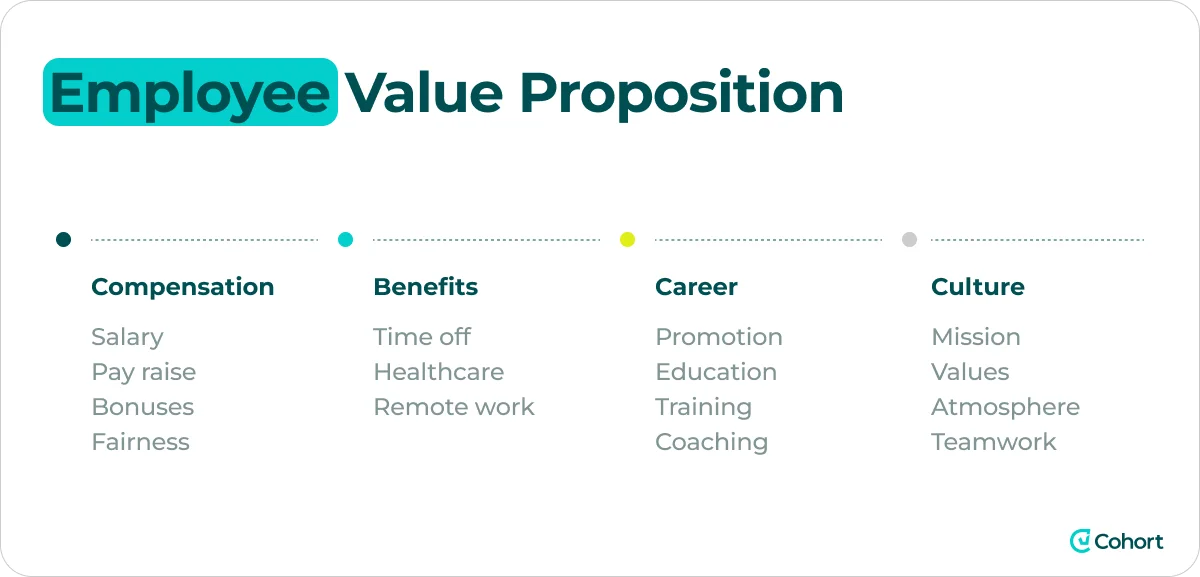
🧠 Why is it important?
A bad reputation can cost a company at least 10% more per hire, making employer branding a critical part of any hiring strategy.
Additionally, according to Glassdoor, 78% of job seekers research a company before applying, and 45% of students rank fairness and inclusion as their top priorities.
✅ Key impact on applicant quality and reputation:
A defined EVP helps companies attract more qualified candidates who align with their values, resulting in better retention and engagement.
🔧 How to act on it:
- Craft a compelling EVP that reflects your actual culture and values.
- Share behind-the-scenes employee stories across LinkedIn and TikTok.
- Use branded visuals, logos, and tone consistently across job listings.
7. Advanced personalization as a rising trend in candidate experience
Generic outreach no longer works.
Candidates expect an experience tailored to their goals, skills, and interests, and companies that get this right see better engagement.
🧠 Why is it important?
Hyper-personalized communication boosts response rates and lowers drop-off.
With 86% of job seekers using their phones to apply, mobile-first experiences are now essential.
✅ Key impact on engagement and application completion:
Personalization makes candidates feel seen, which improves application rates and keeps them in your pipeline longer.
🔧 How to act on it:
- Utilize AI to send personalized follow-ups tailored to candidate behavior.
- Personalize outreach with details about role fit or company mission.
- Ensure your career site and applications are optimized for mobile use.
8. Virtual hiring as a cornerstone of the future of tech recruitment
Hiring doesn’t stop at the interview, as virtual hiring now covers everything from screening to onboarding.
Most tech candidates expect the entire process to happen remotely.
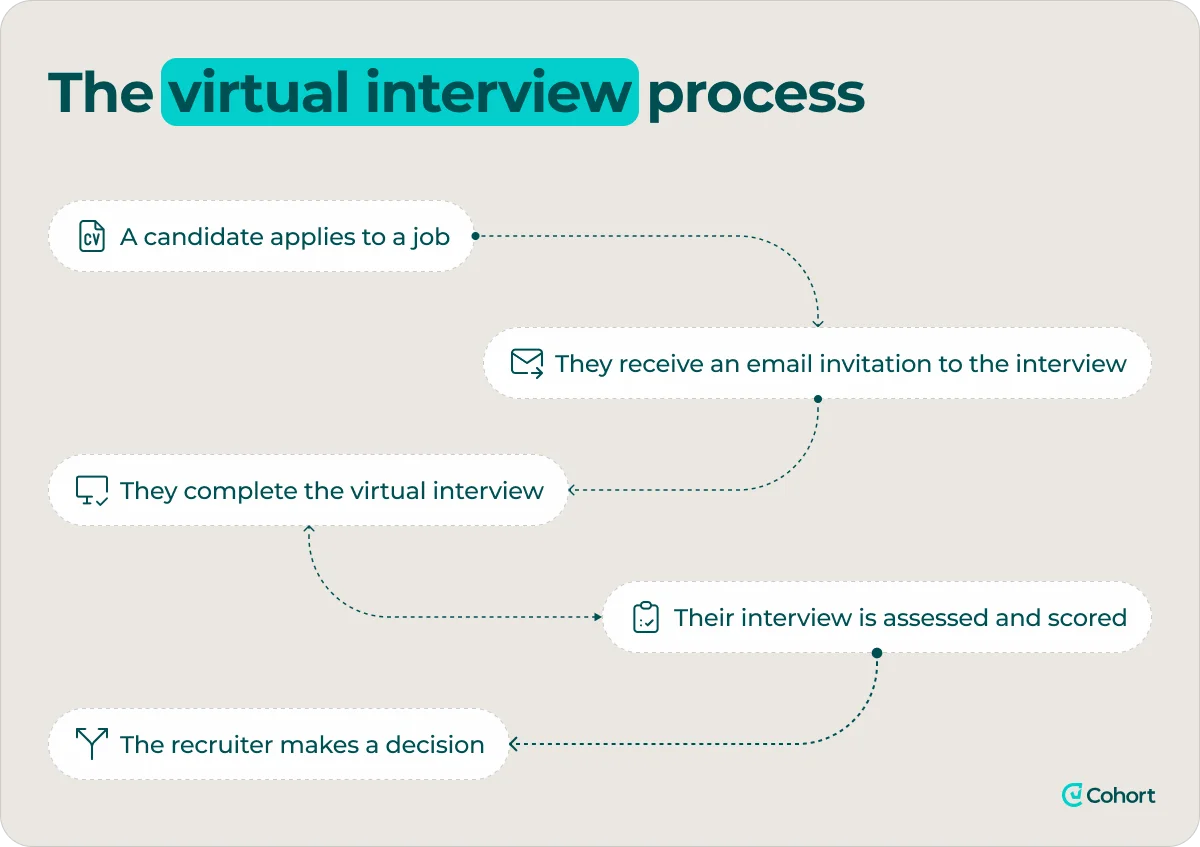
🧠 Why is it important?
During the COVID-19 pandemic, remote work surged, with 27% of people initially working from home.
By August 2020, that number had climbed to 44% in the U.S.
This rapid shift made effective virtual onboarding essential for supporting and retaining new hires.
✅ Key impact on reach and candidate experience:
Virtual hiring expands access to talent while maintaining a connected and professional candidate experience.
🔧 How to act on it:
- Use video interview platforms and remote job previews.
- Assign a “virtual recruiter” or TA coordinator to guide candidates through the process.
- Utilize digital recruiting tools to support new hires from the outset.
9. Building specialized talent pools for in-demand tech roles
One-size-fits-all sourcing doesn’t work anymore.
Recruiters are now building custom pipelines to meet the demands of the future of tech hiring, such as AI, cybersecurity, and data engineering.
🧠 Why is it important?
90% of tech hiring managers say they struggle to find specialized talent.
These roles often require deep expertise that general sourcing methods can’t reach.
✅ Key impact on niche hiring and technical project success:
Tailored talent pipelines help companies fill complex roles faster and avoid skill shortages in key areas.
🔧 How to act on it:
Build networks in niche communities, such as GitHub or Kaggle.
Offer targeted referral bonuses and internal upskilling options.
Run academies or mentorship tracks for in-demand skills.
10. Candidate assessments driving fairer, faster tech hiring
Tech hiring is becoming more evidence-based.
Companies rely on assessments to gauge real-world skills, not just what’s on a CV.
🧠 Why is it important?
78% of HR leaders report a better quality of hire after using skill-based assessments.
These tests make screening faster and fairer.
✅ Key impact on objectivity and hiring speed:
Assessments filter out unqualified applicants early while reducing reliance on guesswork and gut feel.
🔧 How to act on it:
- Use coding tests, work samples, or job simulations.
- Integrate assessments early in the funnel to reduce drop-off.
- Provide clear instructions and feedback to candidates after the test.
11. SEO for recruitment that boosts talent visibility
Job seekers now find roles the same way they shop, and that is through search engines.
Your career site needs to be optimized like any other digital product.
🧠 Why is it important?
70% of job searches begin on Google, and 84% of candidates apply directly through search results.
Without SEO, your job post won’t be seen.
✅ Key impact on traffic and application rates:
A well-optimized careers page attracts more qualified candidates with reduced advertising spend.
🔧 How to act on it:
- Use clear job titles and keywords that candidates actually use in their job searches.
- Add structured data so listings show up in Google for Jobs.
- Ensure pages load quickly and function properly on mobile devices.
12. Asynchronous video interviews and the new hiring norm
Video interviews have become a standard part of modern hiring, enabling teams to screen candidates more efficiently while providing applicants with greater flexibility.
Some companies are going further, as one LinkedIn job ad asked candidates to skip the CV and send a 3–5 minute video introducing themselves and explaining their fit.
This shift reflects how video is reshaping early-stage screening in tech recruitment.
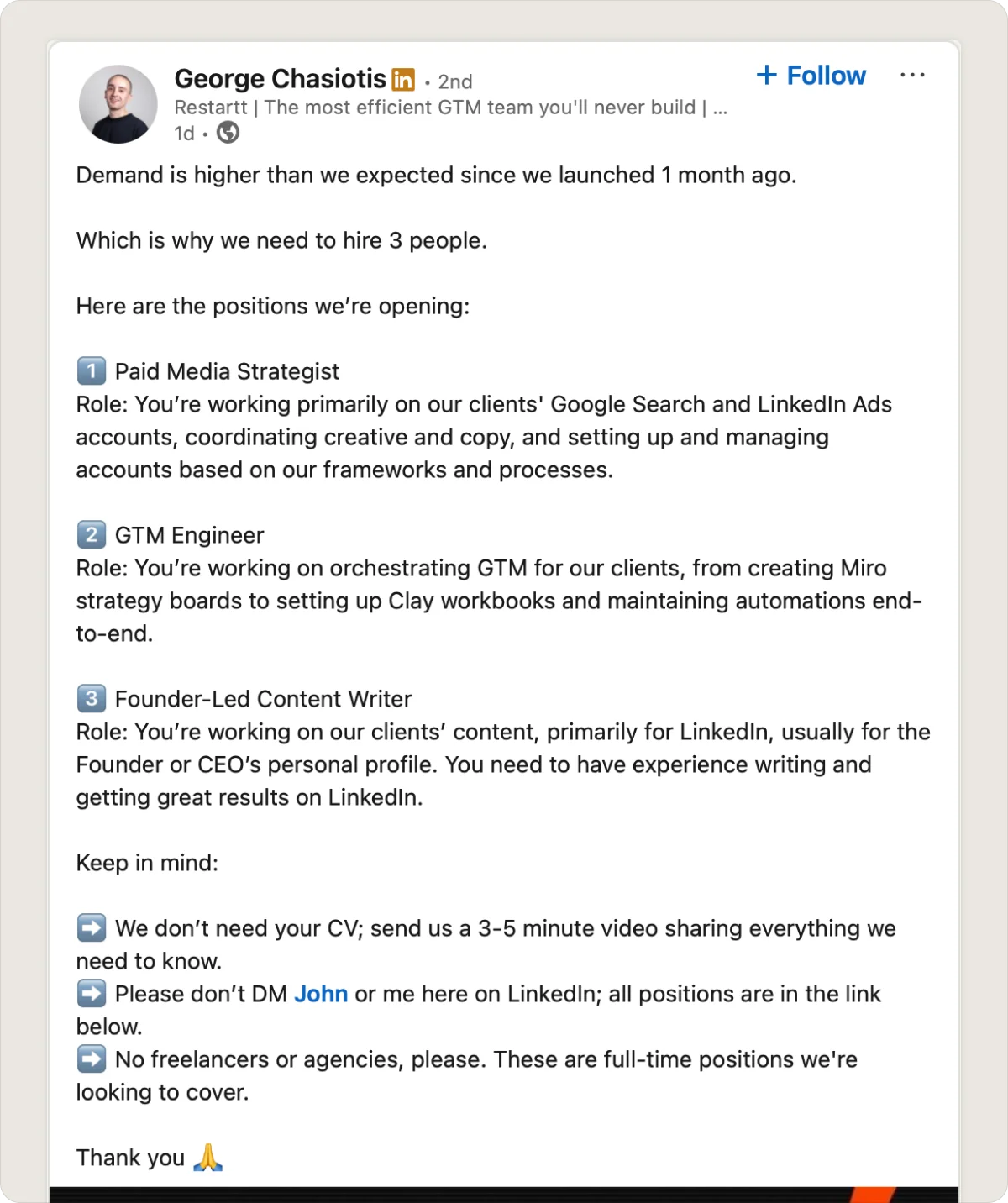
🧠 Why is it important?
81% of recruiters now use video interviews, and 47% say this reduces time-to-hire.
It also opens up scheduling for global or remote candidates.
✅ Key impact on flexibility and efficiency:
Video tools allow asynchronous screening and shorten interview timelines without sacrificing insight.
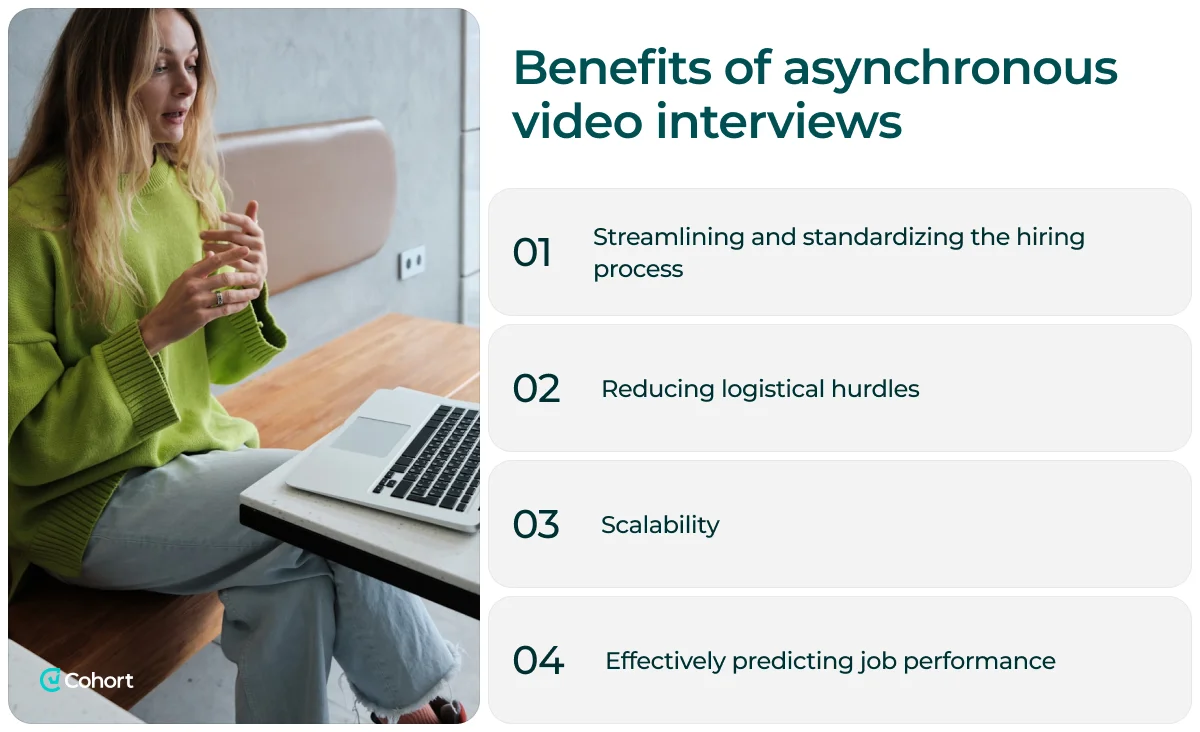
🔧 How to act on it:
- Offer one-way video questions as an initial filter.
- Train hiring managers to consistently evaluate videos.
- Use a branded video intro to set expectations for candidates.
13. Flexible work benefits as a key driver in tech recruitment
Flexibility is now a top reason candidates accept or reject a job.
It’s more than remote, as it includes PTO, hours, and family perks.
🧠 Why is it important?
Slightly over half (51%) of job seekers would choose flexibility over higher pay.
The number is even higher among women (53%) and experienced workers (56%), showing just how critical flexible work has become for attracting and retaining talent.
✅ Key impact on attraction and retention:
Flexible perks make your job offers more competitive and keep your top performers engaged.
🔧 How to act on it:
- Promote flexible schedules and hybrid options in job ads.
- Create internal policies for work-from-anywhere roles.
- Offer benefits like mental health days or childcare stipends.
14. Automating candidate relationship management for long-term value
Recruiters are keeping pipelines warm, not just full.
Automation tools help you stay in touch with past candidates and reduce the need for sourcing from scratch.
🧠 Why is it important?
91% of companies with 10 or more employees now use CRM software, leading to faster time-to-fill and improved candidate re-engagement.
✅ Key impact on long-term pipeline and candidate loyalty:
Automated outreach builds stronger candidate relationships and turns previous applicants into future hires.
🔧 How to act on it:
- Set up drip campaigns for past candidates and silver medalists.
- Use tagging to organize talent pools by skill, location, or role.
- Automate alerts when new roles match someone in your database.
15. Upskilling is a must-have for the future of tech hiring
Tech workers want more than a job, as they want chances to grow, and training is now an important part of what attracts them.

🧠 Why is it important?
84% of employees want ongoing learning opportunities at work, and 44% of companies are ramping up internal training to retain their talent.
✅ Key impact on employee growth and internal mobility:
Upskilling attracts ambitious candidates and helps you fill roles from within, reducing turnover and hiring costs.
🔧 How to act on it:
- Offer learning stipends or access to online courses.
- Build clear career paths and promotion frameworks.
- Highlight growth opportunities in your job descriptions.
Cohort AI: Powering Smarter Tech Recruitment in 2025
Cohort AI helps modern hiring teams move faster, reach better candidates, and reduce manual work.
It utilizes AI to enhance every stage of recruitment, from identifying candidates to engaging them and constructing robust shortlists.
The platform's smart agents handle time-consuming tasks, allowing your team to focus on what matters most: selecting the right people.
Here’s what Cohort AI can do:
- Find hidden talent: Sally the Scout searches platforms like GitHub and online portfolios to discover skilled candidates who aren’t actively applying.
- Send personal messages: Pete the Prospector creates custom outreach messages in your brand’s voice, helping increase reply rates with no extra effort.
- Score candidates fairly: The Talent Graph ranks candidates based on skills, potential, and working style, not just job titles or resumes.
- Follow up automatically: Charlie the Closer keeps candidates warm with updates, reminders, and answers to common questions, so you never lose a good lead.
- Build fast shortlists: Skip manual filtering and get ready-to-review candidates who actually match the role.
Struggling to keep up with tech hiring demands while still giving candidates a great experience?
Let AI handle the busywork, so your team can focus on what matters.
Book your free demo of Cohort AI and see how smarter sourcing leads to better hires.













